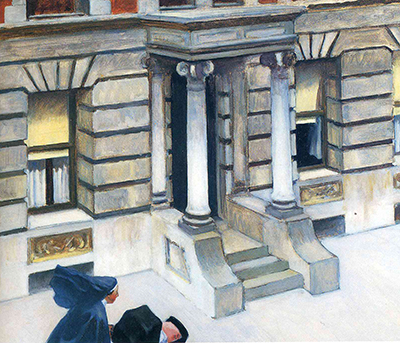Edward Hopper was born in New York in 1882. In 1900 he enrolled in the New York School of Art where he studied illustration and fine art for the next six years. Upon completion of his education, he visited Paris, France three times between 1906 and 1910.
Painted in 1924, ‘New York Pavements’, is a fine example of Edward Hopper’s fascination with architecture. The painting offers a bird’s eye view of a house constructed of large gray bricks and a portico supported by four columns. The building seems to be a row house in a neoclassic style inspired by Greek and Roman architecture.
The house appears to be in an upper-class neighborhood. Not only are the three steps leading up to the house and the pavement scrupulously clean, a nanny in traditional 1900s garb is taking her charge out for a walk.
The time of year of the painting could be late summer or early fall. It’s still warm enough for one of the windows of the house to be open, but a breeze flutters the white net curtain as well as the blue headdress of the nanny. It also appears to be a chilly day as the nanny is wearing a cape.
The pram the nanny is pushing is rather unusual in design. While most prams have a push bar at the foot end of the pram, the pram in this painting has the push bar at the head. Barely noticeable is the white sheet folded over a pink blanket.
‘New York Pavements’ is on oil on canvas, measuring 24.75 x 29.75 inches and was a gift of Walter P. Chrysler, Jr. to the Chrysler Museum of Art.
A very similar painting by Edward Hopper is called ‘Summertime’, painted in 1943, which shows a young woman on the bottom step of a Neoclassical house. Once again, the house is constructed of large gray bricks, with a column supported entrance.
The season is clearly summer as one window of the house is open and the young woman is dressed in a light blue dress and is wearing a wide brimmed hat to shield her from the sun. She appears to be waiting for someone as her hand rests against one of the columns and she gazes in the distance.




